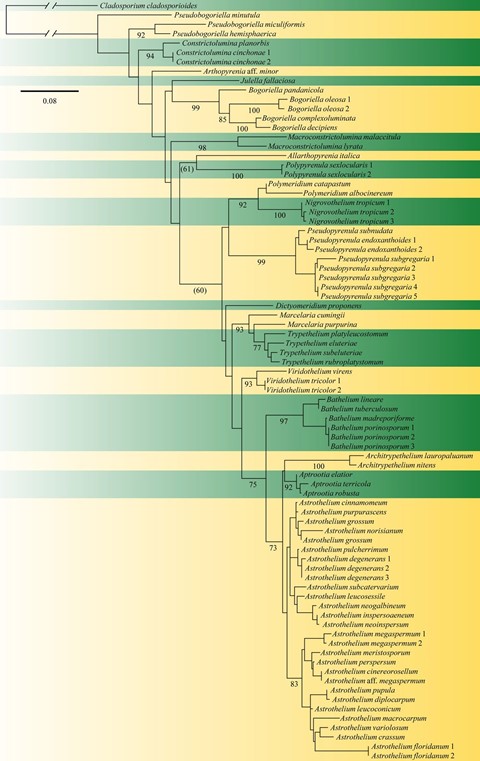Pseudobogoriella Lücking, R. Miranda & Aptroot gen. nov.
MycoBank number: MB 836794; Index Fungorum number: IF 836794; Facesoffungi number: FoF 08807; 15 morphologically defined species (this paper); molecular data available for three species (Lücking et al. 2016; this paper).
Diagnosis: Differing from Bogoriella chiefly in the smaller ascospores always lacking endospore thickenings.
Etymology: The name refers to the notion as a “false” Bogoriella, i.e. similar but not closely related to the latter.
Lichenized (sometimes barely so or apparently nonlichenized) on bark in terrestrial, chiefly lowland to lower montane tropical habitats. Thallus ecorticate, mostly whitish to pale brownish or pinkish. Photobiont Trentepohlia. Ascomata solitary, erumpent to prominent, brown-black to carbonaceous, hemisphaerical to wart-shaped, coriaceous to carbonaceous, ostiolate, ostiole apical to rarely lateral. Involucrellum usually well-developed, carbonaceous. Excipulum prosoplectenchymatous, usually brownish, in lateral and apical parts typically fused with the involucrellum. Hamathecium comprising 1 µm wide para-physoids, hyaline, straight to somewhat wavy, branched and anastomosing, embedded in a thin, gelatinous matrix. Asci 8-spored, bitunicate, fissitunicate, clavate to fusiform, short pedicellate, with a non- amyloid ocular chamber. Ascospores irregularly arranged to uni- or biseriate, fusiform-ellipsoid, grey-brown, 1-septate, with eusepta and rectangular lumina, wall finely granular ornamented, not or slightly constricted at the septa, typically rather small (mostly around 15–20 × 6–8 µm), only in the type species somewhat larger. Pycnidia known from a few species, immersed to erumpent, visible as black dots. Conidia aseptate, bacillar, hyaline.
Chemistry: no substances detected by TLC.
Type species: Pseudobogoriella hemisphaerica (Müll. Arg.) Lücking, R. Miranda & Aptroot (see below).
Notes: The establishment of this new genus follows the topology of the phylogenetic tree, in which former members of Mycomicrothelia sensu lato emerge on three separate clades (Fig. 77). The systematics of these taxa is not settled, given that only few species have been sequenced. Pseudobogoriella currently represents a paraphyletic grade of two clades, but we have adopted the conservative solution of merging the two clades into a single genus for the time being. This reflects the fact that these species cannot be classified in Bogoriella sensu stricto for topological reasons, but at the same time too few data are available to further resolve this basally emerging grade. The main difference when com- pared to Bogoriella are the small, 1-septate ascospores lacking endospore thickenings.

Fig. 77 Best-scoring maximum- likelihood tree of Trypetheliaceae, showing all currently sequenced and recognized genera, based on the mtSSU marker, with a length of 962 bases. The tree was reconstructed in RAxML 8, using the universal GTR-Gamma model without site partitioning, and the final likelihood was – 7368.672686. The currently accepted genera are highlighted
Species
